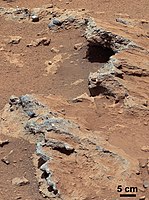
Photo from wikipedia
Abstract Ice core records of atmospheric methane ( CH 4 ) and its isotopic composition provide important information about biogeochemical cycles in the past. Interpreting these data requires that they… Click to show full abstract
Abstract Ice core records of atmospheric methane ( CH 4 ) and its isotopic composition provide important information about biogeochemical cycles in the past. Interpreting these data requires that they faithfully record the composition of the atmosphere. In this study, we describe anomalies of up to 30–40 ppb CH 4 that are only observed in dust-rich ( > ∼ 60 ng Ca/g ice), glacial-period ice measured with standard melt-refreeze methods. The stable isotopic composition of CH 4 is also significantly affected. Results from the GISP2 and NEEM ice cores from Greenland show that excess CH 4 is either released or produced in the presence of liquid water in amounts which are highly correlated with the abundance of Ca 2 + and mineral dust in the sample. Additional experiments show that excess CH 4 is unaffected by the addition of HgCl 2 (a microbial inhibitor) and is not related to ice core storage time. Dust concentrations in Antarctic ice cores are an order of magnitude lower than in Greenlandic ice cores and no excess CH 4 was observed in samples from the Antarctic WAIS Divide (WD) and South Pole (SPICE) ice cores. While the overall structure of the ice core atmospheric methane history is minimally impacted by excess CH 4 , the impacts on the isotopic record and on inverse models used to reconstruct CH 4 sources are greater. We propose three potential mechanisms to explain the presence of excess CH 4 : (1) that CH 4 is adsorbed on dust particles prior to deposition on the ice sheet and is slowly desorbed during the melt-extraction step of sample analysis; (2) that dust acts as a micro-environment within the ice sheet for methanogenic extremophiles; or (3) that excess CH 4 is a product of abiotic degradation of organic compounds during the melt-extraction step of sample analysis.
Journal Title: Geochimica et Cosmochimica Acta
Year Published: 2020
Link to full text (if available)
Share on Social Media: Sign Up to like & get
recommendations!